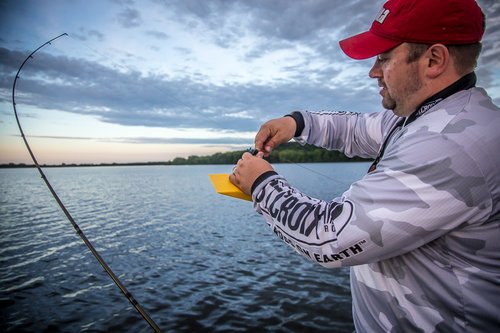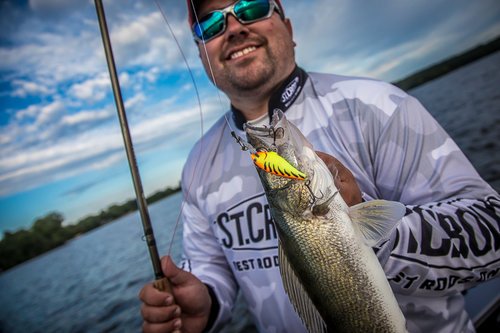It seemed like only yesterday when we buried the jig box for more “summery” walleye presentations. The lead heads and sharp hooks we favored around the walleye-opener have given way to live bait rigs, cranks, and spinners with bottom bouncers. Some of us, especially the river-anglers, never put away our jig offerings, but for the most part we’ve moved-on. As fall water temperatures and fish locations begin to mirror spring, the jig bite comes full circle, once again being a productive strategy as it was in the spring. This time however, there’s fewer anglers on the water you’ll have to share the bounty with.
Veteran guide Tony Roach needs little introduction, and it’s likely no surprise that he wields a jig like you and I use the air to breathe. On an October trip with him a few years ago, we pitched jigs exclusively, and threw them in many places you might not expect. “I start in 6 foot of water and shallower,” says Roach. “I see plenty of guys focus on 8-12 foot rocks and sand, but in the fall you can find big concentrations of fish up shallow. When they’re up tight, they bite, it’s as simple as that.” Bite they did, with us finding pods of fish scattered in shallow rock situations that “felt” too shallow. Arguing with the fish and where they “should” be is futile as I’ve come to find, so we stayed in shallow clear water, made long casts, and continued to catch fish.
We didn’t hesitate to slip out to deeper spots for other fish at the same time. Again, fish where the fish are, and understand that not all fish in any one system respond to the environmental indicators of wind, water temperature, and bait equally and simultaneously. Fall can be confusing that way, with all the dynamic changes that are occurring, fish location can be scattered. Walleyes coming out of their summer patterns can still be quite deep during this period, with other fish transitioning shallower hour by hour. The point to understand however is that no matter how many fish may still be at depth, those fish up shallow, when found, are likely biters.
Among all of the signaling factors that can push fish shallow, water temperature is the most consistent bellwether. “I’m looking for surface temps in the 55 degree range to really trigger the begging of the strong fall pattern,” says Roach. “I fish aggressive early, power fishing the reefs and rock ledges, and then as surface temps hit the 45-50 degree range, I’m dragging the bait with a few slow pops mixed in,” offers Tony.
Just as spring live-bait situations eventually give way to more aggressive plastics presentations, the same happens in the fall but in reverse. Tony says, “I’m starting with plastics earlier, to pair with the faster fishing I do.” Surely, the action and colors available aid in this aggressive fishing approach, making the bait more appealing from a distance. The combination of shallow fish, and a strong jig and plastics bite can make for some of the fastest fishing of the year, allowing anglers to cover water while fishing quickly and getting bit along the way. Big grub imitations, or longer ring-worm baits work favorably, with minnow-style baits working well later in the fall.
As fall progresses and water temps slow a fish’s metabolism, it should come as no surprise that live bait offerings become the order of the day once more. The same jig and shiner combination that was so deadly this spring, is once again the best selection for getting shallow fish to commit. Fishing these live-bait offerings slowly is once again the key, with some fish preferring the bait almost motionless. Less is more during some of cold, late-fall excursions, as the liveliness of the minnow is what often ends up sealing the deal for the few walleye anglers that have chosen the boat instead of a tree-stand.
That’s not to say that fish are always inactive and prefer a crawling presentation that time of year. “A warm afternoon sun and flat conditions can actually bring up the water temperatures a good deal,” says Roach. Experiment with plastic offerings in these situations as fish become more aggressive. Don’t be afraid to move more quickly from spot to spot, while fishing more quickly. Let the fish be your guide and choose accordingly.
If water temperature is the primary driver of this migration of fish locations, wind is surely a close second, often taking a good situation and making it even better. Many of the best trips I’ve ever had are when water temps hit the low 50’s, and a 15mph-plus wind stacks bait on shoreline rocks and sand. Tony agrees. “There’s lots of times when I’m throwing baits in those situations right up against rocks and reed-edges, and the bite happens almost instantly,” says Roach. Fish fast in these situations, as you’re playing with a deck stacked in your favor. Fish won’t be everywhere, but key shoreline points with any structure whatsoever will hold actively feeding fish. All you need to do is put a jig in front of them.
What once became old, becomes new again, as spring gives way to summer and finally fall again. Dig out the jigs, and fish them with plastics or meat depending on the temps you’re seeing. Just remember to start shallow and fear not the water less than 6 feet. You might be surprised to find yourself at the end of the season, in the very same locations that you started it.





